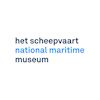
03. Noord 0, Republic at Sea: Battle of Gibraltar
The Low Countries struggled for eighty years, between 1568 and 1648, to free themselves from the rule of their king, Philip The Second of Spain. This painting by Cornelis van Wieringen depicts a major maritime victory by the Dutch over the Spanish, which took place halfway through the Eighty Years’ War, or Dutch Revolt as it is also known. The Spanish fleet, lying at anchor in the Bay of Gibraltar, was taken completely by surprise by a Dutch attack. We can see cannon balls being fired, plumes of smoke filling the horizon, vessels being sunk and drowning sailors fighting for their lives. On the right-hand side of the canvas, you can see the iconic Rock of Gibraltar. The Spanish fleet was defeated and the battle led to peace negotiations with Spain and a ceasefire that lasted twelve and a half years. The painting was commissioned as a gift for Prince Maurits of Orange, the leader of the Dutch Revolt against Spain. It was intended as a reminder of the importance of cooperation between the Seven Provinces. In the Battle of Gibraltar, the Admiralties of the Dutch Republic acted together for the first time in combat against their common enemy – and with considerable success!


The National Maritime Museum
Het Scheepvaartmuseum (The National Maritime Museum) shows the strong connection between the maritime world and society as a whole, and more specifically the impact of this on the lives of many individuals. The collection of The National Maritime Museum is one of the largest and most notable maritime collections in the world with approximately 400,000 objects, including paintings, models of ships, navigation instruments, and maps of the world. Discover 500 years of Dutch Maritime history as well as its strong links to today’s society and the society of the future.
- Kattenburgerplein 1
- Amsterdam Netherlands
- (020) 52 32 222
- www.hetscheepvaartmuseum.nl
